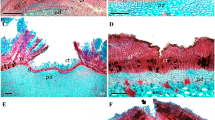Summary
Solute concentration gradients were studied in Ricinus communis L. stems using refractometry linked with cryoscopic measurements of osmotic pressure. Techniques were developed to study the local composition of sieve-tube sap, effectively isolating bark segments by ring-massage or massage-girdling. In intact plants concentration gradients in stems were found to be steep near leaves, as reported previously, and also near roots. However, when transport from these organs was prevented, the steep gradients disappeared. Apparently they are caused by sap influx from nearby organs into stems during sampling. Concentration gradients in stems proper were almost negligible under standard growing conditions. They became positive (more concentrated above) when photosynthesis was enhanced, and negative in darkness.
During exudation, leaves could secrete abundant concentrated sap for long periods. Stems had a similar but more limited capacity to secrete and, to a still lesser extent, roots also. Secretion was triggered even from natural sinks by exudation from an incision. Release from turgor pressure seems responsible rather than dilution of the phloem sap, suggesting that in whole plants a sink induces secretion and pressure-flow from distant sources by regulating the pressure within sieve tubes. The rate of exudation decreased as sap concentration fell, indicating that a reduction in pressure corresponds to assimilate exhaustion.
The hydraulic conductivity of bark was not high, but was greater when the bark was secreting solutes. A change in mass-flow conduction between sieve tubes and storage cells is proposed to explain these differences in water permeability.
The common assumption that solute concentration gradients correspond to pressure gradients seems inapplicable to whole Ricinus plants. Solute transfer can exceed the water flux so that osmotic equilibrium may not be reached at a particular location. In intact plants, solute gradients probably reflect source and sink activity with the interconnecting sieve tubes behaving rather passively, like pipes with a solute exchange-capacity. Actual pressure differences in sieve tubes are best indicated by sap concentration differences between source and sink. In Ricinus plants 0.5–1 m tall these pressures can be 5–10 bar.
Similar content being viewed by others
References
Arisz, W. H.: Intercellular polar transport and the role of plasmodesmata in coleoptiles and Vallisneria leaves. Acta bot. neerl. 18, 14–38 (1969)
Crafts, A. S.: Phloem anatomy, exudation, and transport of organic nutrients in cucurbits. Plant Physiol. 7, 183–225 (1932)
Currier, H. B.: Callose substance in plant cells. Amer. J. Bot. 44, 478–488 (1957)
Dixon, H. H., Gibbon, M. W.: Bast sap in plants. Nature (Lond.) 130, 661–662 (1932)
Esau, K.: Plant anatomy, New York-London-Sydney: Wiley 1965
Hall, S. M., Baker, D. A., Milburn, J. A.: Phloem transport of 14C labelled assimilates in Ricinus. Planta (Berl.) 100, 200–207 (1971)
Hall, S. M., Milburn, J. A.: Phloem transport in Ricinus: Its dependence on the water balance of the tissues. Planta (Berl.) 109, 1–10 (1973)
Hammel, H. T.: Measurement of turgor pressure and its gradient in the phloem of oak. Plant Physiol. 43, 1042–1048 (1968)
Huber, B., Schmidt, E., Jahnel, H.: Untersuchungen über den Assimilatstrom. Tharandt. Forstl. Jb. 88, 1017–1050 (1937)
Lang, A. R. G.: Osmotic coefficients and water potentials of sodium chloride solutions from 0 to 40° C. Austr. J. Chem. 20, 2017 (1967)
Mason, T. G., Maskell, E. J.: Studies on the transport of carbohydrates in the cotton plant. II. The factors determining the rate and the direction of movement of sugars. Ann. Bot. 42, 571–636 (1928)
Milburn, J. A.: An analysis of the response in phloem exudation on application of massage to Ricinus. Planta (Berl.) 100, 143–154 (1971)
Milburn, J. A.: Phloem transport in Ricinus. Pestic. Sci. 3, 653–665 (1972)
Milburn, J. A.: Xylem and phloem transport in Ricinus. Johri Commemoration Vol., India (in press).
Münch, E.: Die Stoffbewegungen in der Pflanze, Jena: Fischer 1930
Peel, A. J., Weatherley, P. E.: Studies in sieve tube exudation through aphid mouth-parts: the effects of light and girdling. Ann. Bot., N.S. 26, 633–646 (1962)
Pfeiffer, M.: Die Verteilung der osmotischen Werte im Baum im Hinblick auf die Münchsche Druckstromtheorie. Flora 32, 1–47 (1937)
Robards, A. W.: The ultrastructure of plasmodesmata. Protoplasma (Wien) 72, 315–323 (1971)
Scholander, P. F., Hammel, H. T., Bradstreet, E. D., Hemmingsen, E. A.: Sap pressure in vascular plants. Science 148, 339–346 (1965)
Tingley, M. A.: Concentration gradients in plant exudates with reference to the mechanism of translocation. Amer. J. Bot. 31, 30–38 (1944)
Zimmermann, M. H.: Translocation of organic substances in trees. III. The removal of sugars from the sieve tubes in the white ash (Fraxinus americana L.). Plant Physiol. 33, 213–217 (1958)
Zimmermann, M. H.: Longitudinal and tangential movement within the sieve tube system of white ash (Fraxinus americana L.). Beih. Z. schweiz. Forstvereins 30, 289–300 (1960)
Zimmermann, M. H.: Translocation of organic substances in trees. V. Experimental double interruption of the phloem in the white ash (Fraxinus americana L.). Plant Physiol. 37, 527–530 (1962)
Zimmermann, M. H.: Transport in the phloem. In: Trees, structure and function, p. 221–279, Zimmermann, M. H. and Brown, C. L. eds. Berlin-Heidelberg-New York: Springer 1971
Author information
Authors and Affiliations
Additional information
Address until August 1974: The Harvard Forest, Petersham, Massachusetts 01366, USA.
Rights and permissions
About this article
Cite this article
Milburn, J.A. Phloem transport in Ricinus: Concentration gradients between source and sink. Planta 117, 303–319 (1974). https://doi.org/10.1007/BF00388025
Received:
Issue Date:
DOI: https://doi.org/10.1007/BF00388025




